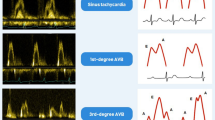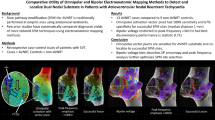Abstract
Background: Complete bi-directional isthmus block is the endpoint of typical atrial flutter ablation. The purpose of this study was to investigate the feasibility of the local double potential (DP) interval and the change in transisthmus conduction time for predicting complete isthmus block after ablation of the cavotricuspid isthmus.
Methods: The study population consisted of 32 patients with typical atrial flutter after a procedure of radiofrequency (RF) ablation of the cavotricuspid isthmus (16 had incomplete block and 16 had complete block). The transisthmus conduction time was determined during pacing from the proximal coronary sinus and low lateral right atrium before and after RF ablation. The DP interval close to the ablation line was evaluated after final RF energy application.
Results: In the counterclockwise direction, transisthmus conduction time had an increase of 37 ± 25.4% and 127.3 ± 35.5% (P < 0.001), and the DP interval was 63.3 ± 8.7 ms and 120 ± 17.4 ms (P < 0.001) after achievement of incomplete and complete block, respectively. The sensitivity, specificity, positive and negative predictive values of an increase in the transisthmus conduction time ≥50% were 100%, 81%, 84% and 100%, respectively; those of DP interval ≥100 ms were 100%. In the clockwise direction, transisthmus conduction time had an increase of 38.8 ± 28.6% and 135.7 ± 63.6% (P < 0.001), and the DP interval was 63.6 ± 13.8 ms and 127.7 ± 27.1 ms (P < 0.001) after achievement of incomplete and complete block, respectively. The sensitivity, specificity, positive and negative predictive values of an increase in the transisthmus conduction time ≥50% were 100%, 67%, 83% and 100%, respectively; those of the DP interval ≥100 ms were 100%.
Conclusions: The transisthmus conduction time ≥50% increase or DP interval ≥100 ms was feasible to predict complete bi-directional isthmus block.
Similar content being viewed by others
References
Poty H, Saoudi N, Abdel Aziz A, et al. Radiofrequency catheter ablation of type I atrial flutter:Prediction of late success by electrophysiological criteria. Circulation 1995;92:1389–1392.
Cauchemez B, Haissaguerre M, Fischer B, et al. Electrophysiological effects of catheter ablation of inferior vena cava-tricuspid annulus isthmus in common atrial flutter. Circulation 1996;93:284–294.
Schwartzman D, Callans DJ, Gottlieb CD, et al.Conduction block in the inferior vena cava-tricuspid valve isthmus: Association with outcome of radiofrequency ablation of type I atrial flutter. J Am Coll Cardiol 1996;28:1519–1531.
Tai CT, Chen SA, Chiang CE, et al. Long-termoutcome of radiofrequency catheter ablation for typical atrial flutter: Risk prediction of recurrent arrhythmias. J Cardiovasc Electrophysiol 1998;9:115–121.
Poty H, Saoudi N, Nair M, et al. Radiofrequency catheter ablation of atrialflutter. Further insights into the various types of isthmus block: Application to ablation during sinus rhythm. Circulation 1996;94:3204–3213.
Shah DC, Takahashi A, Jais P, et al. Local electrogrambased criteria of cavotricuspidisthmus block. J Cardiovasc Electrophysiol 1999;10:662–669.
Villacastin J, Almendral J, Arenal A, et al.Usefulness of unipolar electrograms to detect isthmus block after radiofrequency ablation of typical atrial flutter. Circulation 2000;102:3080–3085.
Tada H, Oral H, Sticherling C, et al. Electrogram polarity and cavotricuspid isthmusblock during ablation of typical atrial flutter. J Cardiovasc Electrophysiol 2001;12:393–399.
Oral H, Sticherling C, Tada H, et al. Role of transisthmus conduction intervals in predicting bi-directional block after ablation of typical atrial flutter. J Cardiovasc Electrophysiol 2001;12:169–174.
Arenal A, Almendral J, Alday JM, et al.Rate-dependent conduction block of the crista terminalis in patients with typical atrial flutter: Influence on evaluation of cavotricuspid isthmus conduction block. Circulation 1999;99:2771–2778.
Scaglione M, Riccardi R, Calo L, et al. Typical atrial flutter ablation: Conduction across the posterior region of the inferior vena cava orifice may mimic unidirectional isthmus block. J Cardiovasc Electrophysiol 2000;11:387–395.
Anselme F, Savoure A, Cribier A, et al. Catheter ablation of typical atrial flutter: A randomized comparison of 2 methods for determining complete bi-directional isthmus block. Circulation 2001;103:1434–1439.
Tsai CF, Tai CT, Yu WC, et al. Is 8-mmmore effective than 4-mm tip electrode catheter for ablation of typical atrial flutter? Circulation 1999;100:711–768.
Tai CT, Chen SA, Chen YJ, et al. Conduction properties of the crista terminalis in patients with typical atrialflutter: Basis for a line of block in the reentrant circuit. J Cardiovasc Electrophysiol 1998;9:811–819.
Anselme F, Saoudi N, Poty H, et al. Catheter ablation of common atrial flutter. Significance of palpitations and quality oflife evaluation in patients with proven isthmus block. Circulation 1999;99:534–540.
Shah DC, Haissaguerre M, Jais P, et al. Simplified electrophysiologically directed catheter ablation of recurrent common atrial flutter. Circulation 1997;96:2505–2508.
Shah D, Haissaguerre M, Jais P, et al. High-density mapping ofactivation through an incomplete isthmus ablation line. Circulation 1999;99:211–215.
Shah D, Haissaguerre M, Takahashi A, et al. Differential pacing for distinguishing block from persistent conduction through an ablation line. Circulation 2000;102:1517–1522.
Author information
Authors and Affiliations
Rights and permissions
About this article
Cite this article
Tai, CT., Haque, A., Lin, YK. et al. Double Potential Interval and Transisthmus Conduction Time for Prediction of Cavotricuspid Isthmus Block after Ablation of Typical Atrial Flutter. J Interv Card Electrophysiol 7, 77–82 (2002). https://doi.org/10.1023/A:1020876317859
Issue Date:
DOI: https://doi.org/10.1023/A:1020876317859




